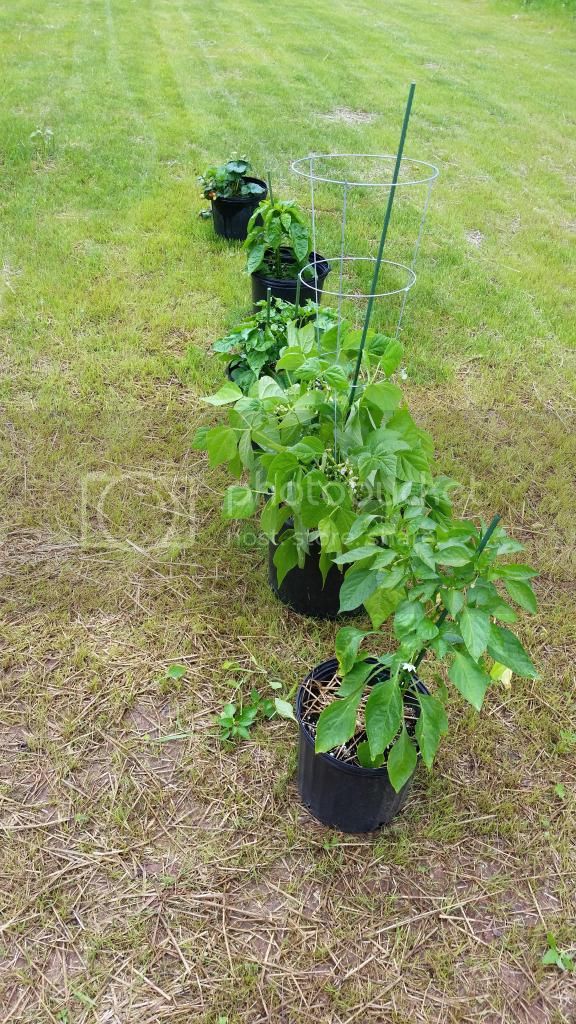Hi all,
I was a long time user a ways back, and got out of growing peppers and now recently have started again. To make a long story short, I planted a few plants at the end of May in pots in my back yard, as the soil here at my new house is too poor and I didn't have the time to make raised beds. I have 1 Trinidad Scorpion, 1 hot bannana, 1 sweet bannana, and another trinidad variant. I got them all locally at a green house.
They have recently started turning very yellow, and plants are dying. It killed off my strawberry plant, and is about to kill my green beans. I cannot see any kind of aphid or bug damage on the plants themsevles, I've carefully inspected them. We've had some very torrential rain here in MD, but with my potting mix and the drainage holes I cannot imagine that overwatering is the issue. I used Pro-mix potting soil (60%) and about 35% earth worm castings and some composted manure bought from a green house. The manure was put carefully on the bottom of the pots as to not burn the new roots. I've also drilled more then the 2 holes in the bottom, so I know they drain quite well. When I dumped my strawberry plant, the soil was dry and looked normal. It is effecting all of my plants, not just peppers. The pepper plants just seem to be fighting whatever the issue is better then the others.
I have heard that using black pots, like I have, could burn the roots of the plants. I would suspect with that though, the plants would look worse off then they do. The temps get to 100+ here. I have also fertilized using an organic mixture bought at a green house, which was 4-5-5. This was after the yellowing started happening. I also used a foilage spray of epsom salt, hearing that helped people with yellow leaves. Still no difference 3 days later. The pictures I'll upload were taken just hours ago. I'll also upload a picture of the plants a month ago. If it helps, the yellowing seemed to start at the bottom leaves, and work its way up every plant. I'm running out of options here as this has never happened to me, and I've grown many times in pots. Any help would be appreciated, as I cant think of anything else do besides move them out of the pots and put them into something else as a desperate move. I've worked really hard and hate for them to die.







Below, please note the plant in front was recently bought, and thats why it looks so "normal":

Below is what the plants looked like a month ago:

Thanks for your time and help. I hope I can find something out to save them.
I was a long time user a ways back, and got out of growing peppers and now recently have started again. To make a long story short, I planted a few plants at the end of May in pots in my back yard, as the soil here at my new house is too poor and I didn't have the time to make raised beds. I have 1 Trinidad Scorpion, 1 hot bannana, 1 sweet bannana, and another trinidad variant. I got them all locally at a green house.
They have recently started turning very yellow, and plants are dying. It killed off my strawberry plant, and is about to kill my green beans. I cannot see any kind of aphid or bug damage on the plants themsevles, I've carefully inspected them. We've had some very torrential rain here in MD, but with my potting mix and the drainage holes I cannot imagine that overwatering is the issue. I used Pro-mix potting soil (60%) and about 35% earth worm castings and some composted manure bought from a green house. The manure was put carefully on the bottom of the pots as to not burn the new roots. I've also drilled more then the 2 holes in the bottom, so I know they drain quite well. When I dumped my strawberry plant, the soil was dry and looked normal. It is effecting all of my plants, not just peppers. The pepper plants just seem to be fighting whatever the issue is better then the others.
I have heard that using black pots, like I have, could burn the roots of the plants. I would suspect with that though, the plants would look worse off then they do. The temps get to 100+ here. I have also fertilized using an organic mixture bought at a green house, which was 4-5-5. This was after the yellowing started happening. I also used a foilage spray of epsom salt, hearing that helped people with yellow leaves. Still no difference 3 days later. The pictures I'll upload were taken just hours ago. I'll also upload a picture of the plants a month ago. If it helps, the yellowing seemed to start at the bottom leaves, and work its way up every plant. I'm running out of options here as this has never happened to me, and I've grown many times in pots. Any help would be appreciated, as I cant think of anything else do besides move them out of the pots and put them into something else as a desperate move. I've worked really hard and hate for them to die.







Below, please note the plant in front was recently bought, and thats why it looks so "normal":

Below is what the plants looked like a month ago:

Thanks for your time and help. I hope I can find something out to save them.
